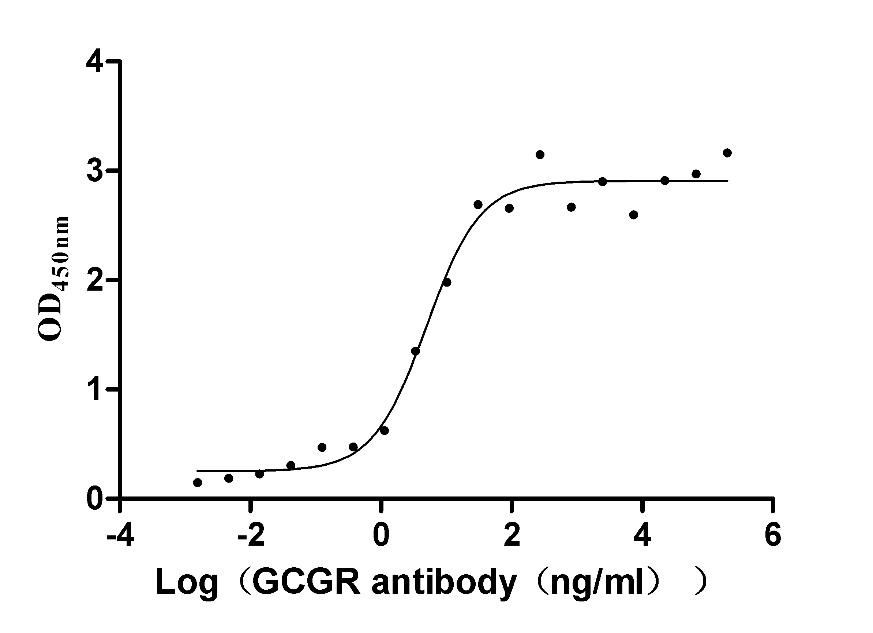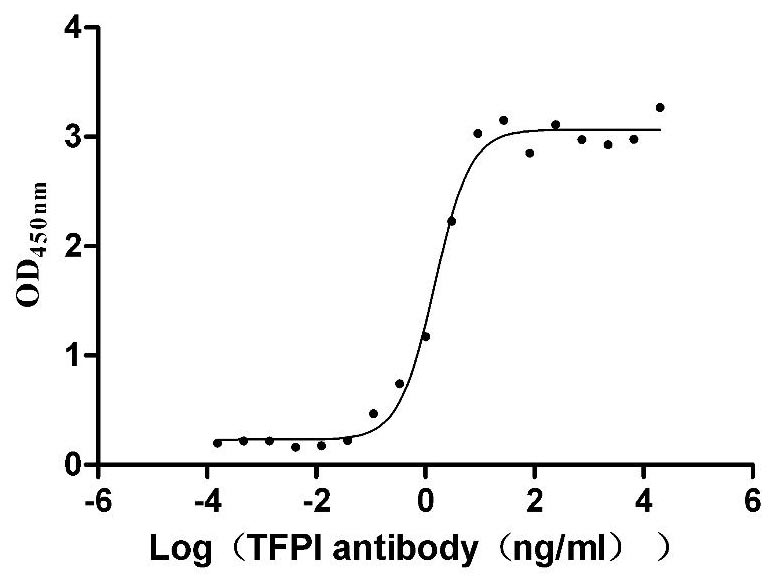Recombinant Mouse Serine/threonine-protein kinase mTOR (Mtor)
-
货号:CSB-YP881349MO
-
规格:
-
来源:Yeast
-
其他:
-
货号:CSB-EP881349MO
-
规格:
-
来源:E.coli
-
其他:
-
货号:CSB-EP881349MO-B
-
规格:
-
来源:E.coli
-
共轭:Avi-tag Biotinylated
E. coli biotin ligase (BirA) is highly specific in covalently attaching biotin to the 15 amino acid AviTag peptide. This recombinant protein was biotinylated in vivo by AviTag-BirA technology, which method is BriA catalyzes amide linkage between the biotin and the specific lysine of the AviTag.
-
其他:
-
货号:CSB-BP881349MO
-
规格:
-
来源:Baculovirus
-
其他:
-
货号:CSB-MP881349MO
-
规格:
-
来源:Mammalian cell
-
其他:
产品详情
-
纯度:>85% (SDS-PAGE)
-
基因名:
-
Uniprot No.:
-
别名:Mtor; Frap; Frap1; Serine/threonine-protein kinase mTOR; EC 2.7.11.1; FK506-binding protein 12-rapamycin complex-associated protein 1; FKBP12-rapamycin complex-associated protein; Mammalian target of rapamycin; mTOR; Mechanistic target of rapamycin; Rapamycin target protein 1; RAPT1
-
种属:Mus musculus (Mouse)
-
蛋白长度:Full length protein of Isoform 2
-
表达区域:1-256
-
氨基酸序列MLGTGPAVATASAATSSNVSVLQQFASGLKSRNEETRAKAAKELQHYVTMELREMSQEES TRFYDQLNHHIFELVSSSDANERKGGILAIASLIGVEGGNSTRIGRFANYLRNLLPSSDP VVMEMASKAIGRLAMAGDTFTAEYVEFEVKRALEWLGADRNEGRRHAAVLVLRELAISVP TFFFQQVQPFFDNIFVAVWDPKQAIREGAVAALRACLILTTQREPKEMQKPQWYRVRDGS TQPLAKHFGLESCSWP
-
蛋白标签:Tag type will be determined during the manufacturing process.
The tag type will be determined during production process. If you have specified tag type, please tell us and we will develop the specified tag preferentially. -
产品提供形式:Lyophilized powder
Note: We will preferentially ship the format that we have in stock, however, if you have any special requirement for the format, please remark your requirement when placing the order, we will prepare according to your demand. -
复溶:We recommend that this vial be briefly centrifuged prior to opening to bring the contents to the bottom. Please reconstitute protein in deionized sterile water to a concentration of 0.1-1.0 mg/mL.We recommend to add 5-50% of glycerol (final concentration) and aliquot for long-term storage at -20℃/-80℃. Our default final concentration of glycerol is 50%. Customers could use it as reference.
-
储存条件:Store at -20°C/-80°C upon receipt, aliquoting is necessary for mutiple use. Avoid repeated freeze-thaw cycles.
-
保质期:The shelf life is related to many factors, storage state, buffer ingredients, storage temperature and the stability of the protein itself.
Generally, the shelf life of liquid form is 6 months at -20°C/-80°C. The shelf life of lyophilized form is 12 months at -20°C/-80°C. -
货期:Delivery time may differ from different purchasing way or location, please kindly consult your local distributors for specific delivery time.Note: All of our proteins are default shipped with normal blue ice packs, if you request to ship with dry ice, please communicate with us in advance and extra fees will be charged.
-
注意事项:Repeated freezing and thawing is not recommended. Store working aliquots at 4°C for up to one week.
-
Datasheet :Please contact us to get it.
靶点详情
-
功能:Serine/threonine protein kinase which is a central regulator of cellular metabolism, growth and survival in response to hormones, growth factors, nutrients, energy and stress signals. MTOR directly or indirectly regulates the phosphorylation of at least 800 proteins. Functions as part of 2 structurally and functionally distinct signaling complexes mTORC1 and mTORC2 (mTOR complex 1 and 2). Activated mTORC1 up-regulates protein synthesis by phosphorylating key regulators of mRNA translation and ribosome synthesis. This includes phosphorylation of ...显示更多
-
基因功能参考文献:
- studies suggest that mTOR regulates vascular integrity and function and that mTOR attenuation may restore neurovascular function and cardiovascular health PMID: 28511572
- Decreased liver mRNA levels for multiple genes associated with mTOR signaling and oxidative stress parameters were detected in aldh5a1(-/-) mice, and several were significantly improved with the administration of mTOR inhibitors (Torin 1/Torin 2). PMID: 27760377
- Results suggest that activation of mammalian target of rapamycin (mTOR)/reactive oxygen species (ROS)/NOD-like receptor protein 3 (NLRP3) signaling may contribute to the development of systemic lupus erythematosus (SLE). PMID: 30060081
- mTOR coordinates transcriptional and metabolic programs in activated Regulatory T cell subsets to mediate tissue homeostasis. PMID: 29844370
- Regnase-1 predominantly regulates mTORC1 signaling. PMID: 30297433
- Study shows that GLP-1 receptor signalling promotes beta-cell glucose metabolism via mTOR-dependent HIF-1alpha activation. findings suggest that chronic GLP-1 actions on insulin secretion include elevated beta-cell glucose metabolism. Moreover, our data reveal novel aspects of GLP-1 stimulated insulin secretion involving de novo gene expression. PMID: 28572610
- metabolic profiling reveals elevated glycolysis and increased mTORC1 signaling in Ndfip1-deficient Treg cells PMID: 28580955
- Sesn2/AMPK/mTOR signaling mediates balance between survival and apoptosis in sensory hair cells under stress. PMID: 28981119
- the present study suggested that Pulsed electromagnetic fields (PEMFs) reduced osteoclast formation from RAW264.7 macrophages via inhibition of the Akt/mTOR signaling pathway. These findings provided novel insight into the mechanisms through which PEMFs suppress osteoclast differentiation. PMID: 29749519
- mTOR signaling is a key mediator of central insulin dysfunction, which leads to pathogenesis of Alzheimer disease. PMID: 29729422
- Results indicate that L-Arg stimulates protein synthesis via the activation of the mTOR (Thr 2446)/p70S6K signaling pathway in an NO-dependent manner. PMID: 29854093
- High mTOR expression is associated with cardiac hypertrophy. PMID: 30125581
- cPKC&-gamma modulated sequential reactivation of mTOR inhibited autophagic flux in neurons exposed to OGD/R, which may provide endogenous interventional strategies for stroke, especially ischemia/reperfusion injury PMID: 29734780
- findings suggest that deficiencies of leucine and isoleucine reduce type I and III tropocollagen syntheses in skin by suppressing the action of mTOR PMID: 29191093
- MTOR-dependent pathways in primordial or growing oocytes differentially affected downstream processes including follicular development, sex-specific identity of early granulosa cells, maintenance of oocyte genome integrity, oocyte gene expression, meiosis, and preimplantation developmental competence. PMID: 29784807
- The control of cMaf expression at the translational level by mTOR regulated the expression of inflammatory genes in response to lipopolysaccharide challenge. PMID: 29484383
- The function of mTOR in epidermal morphogenesis is split between mTORC1 and mTORC2. Whereas mTORC1 mainly controls keratinocyte proliferation within the basal layer, early epidermal stratification and differentiation, mTORC2 primarily controls cell division orientation and late stage barrier formation of the interfollicular epidermis. PMID: 27807348
- Loss of mTOR in vasoactive intestinal peptide neurons displayed erratic circadian behavior and weakened synchronization among cells in the suprachiasmatic nucleus, the master circadian pacemaker. PMID: 29555746
- T1R1/T1R3 modulates the mTOR pathway to regulate milk protein synthesis in the mouse mammary gland in vivo. PMID: 28497545
- the protein expression levels of mTOR were significantly reduced in spinal cord injury (SCI) neurons, whereas transfection with a miR99b5p inhibitor suppressed the SCIinduced reduction of mTOR. PMID: 29039596
- Adoptive transfer with targeting-mTOR strategy markedly improves neuronal recovery after ONI, supporting the therapeutic potentials of Tregs in acute and chronic neurological disorder PMID: 27886260
- Activation of the mTOR pathway was partially repressed by T1R1 siRNA or SLC7A5/SLC3A2 inhibitor (BCH, 10 mM), and the combination of these two treatments further repressed the activity of mTOR pathway. PMID: 27539583
- Ggpps deletion enhanced Rheb farnesylation, which subsequently activated mTORC1 and facilitated spermatogonial differentiation PMID: 27374985
- mTOR is crucial for T-cell accumulation in the GI tract and for establishing local adaptive immunity against pathogens. PMID: 27731345
- Data show that mammalian/mechanistic target of rapamycin (mTOR) perturbation alters the suprachiasmatic nucleus (SCN) clock oscillations. PMID: 29750810
- These data demonstrate that the activated mTOR by Erk1/2 results in energy consumption, which in turn leads to endoplasmic reticulum stress signaling and thus induces apoptosis in high glucose-treated podocytes. PMID: 29554648
- Inhibition of mammalian target of rapamycin (mTOR) activation using rapamycin restored Mb mRNA expression to control levels. Lipid supplementation had no effect on Mb gene expression. Thus, IGF-1-induced anabolic signaling can be a strategy to improve muscle size under mild hypoxia, but lowers Mb gene expression PMID: 28862673
- These results demonstrate that mTOR acts as a molecular rheostat of natural killer cell reactivity controlled by educating receptors and uncover how cytokine stimulation overcomes natural killer cell education. PMID: 28875936
- ResultsPIA suppressed phosphorylation of all mTOR proteins PMID: 28399115
- MTOR plays a critical role in the regulation of cortical interneuron number and autophagy in the developing brain. PMID: 28598226
- in the central nervous systems (CNS), the mammalian target of rapamycin (mTOR) pathway plays a critical role in regulating the regenerative capacity of neurons. PMID: 28666378
- mRNA localization enables spatiotemporal control of mTOR pathways regulating local translation and long-range intracellular signaling. PMID: 29567716
- These findings revealed mTOR overactivation in mesenchymal cells aggravates CCl4- induced liver fibrosis and the rapamycin prevent its occurance. PMID: 27819329
- present study demonstrates that endothelial mTORC1 deletion protects against hindlimb ischemic injury in diabetic mice possibly via activation of autophagy, attenuation of oxidative stress and alleviation of inflammation PMID: 28473248
- The AMPK, mTOR and p70S6K proteins were not significantly changed. PMID: 28738521
- Preventive function of Sirt1 may be the inhibition of mTOR phosphorylation, whereas mTOR activity was shown to be a pathogenic culprit of systemic sclerosis in the current research. PMID: 28532580
- CRP is pathogenic in type-2 diabetes (T2DN). CRP may promote CD32b- NF-kappaB signaling to mediate renal inflammation; whereas, CRP may enhance renal fibrosis in T2DN via CD32b-Smad3-mTOR signaling. PMID: 27221338
- These results reveal a novel role of miR-199a as a key regulator of cardiac autophagy. PMID: 26160071
- An FAK-YAP-mTOR Signaling Axis Regulates Stem Cell-Based Tissue Renewal in Mice. PMID: 28457749
- Our results suggest that mTORC1/mTORC2 dual inhibition is more effective for anti-angiogenic therapy, as it impairs not only endothelial cell proliferation, but also endothelial cell elongation. PMID: 29428724
- These results reveal that MTOR is dispensable for the maintenance of undifferentiated spermatogonia, but is cell autonomously required for their proliferation and differentiation. PMID: 28379293
- mTOR mediates metabolic adaptation of antigen-presenting cells in distinct tissues, influencing the immunological character of allergic inflammation. PMID: 28798047
- mTOR Inhibition Subdues Milk Disorder Caused by Maternal VLDLR Loss PMID: 28591574
- AKAP1 is a transcriptional target of Myc, and it supports mTOR pathway and the growth of cancer cells. PMID: 28569781
- our results show that the phosphorylation of 4E-BP1 promotes translation at the onset of meiosis to support the spindle assembly and suggest an important role of CDK1 and mTOR kinases in this process PMID: 28272965
- Inhibition of mTOR complex 1 is closely associated with aging and prolonged life span of fission yeast. PMID: 28526373
- Suggest that hyperactivation of the mTOR pathway is involved in the development of endometrial hyperplasia with aging. PMID: 27980219
- Abeta increases the expression of mTOR and p-mTOR at the site of Ser2448, and the stimulation of Abeta is likely to depend on sirtuin 1, PPARgamma, and PGC-1beta pathway in regulating mTOR expression. PMID: 27631411
- In mTOR gene deletion, the astrocyte population exhibited a lower seizure frequency compared with controls in an animal model of temporal lobe epilepsy. PMID: 26732600
- UVB-irradiated or aged mice skin revealed that mTORC2 activity was significantly upregulated which in turn increased Akt activation and Akt-dependent IkappaB kinase alpha (IKKalpha) phosphorylation, and The increased mTORC2 signaling pathway during skin aging were associated to NF-kappaB activation. PMID: 27486771
收起更多
-
亚细胞定位:Endoplasmic reticulum membrane; Peripheral membrane protein; Cytoplasmic side. Golgi apparatus membrane; Peripheral membrane protein; Cytoplasmic side. Mitochondrion outer membrane; Peripheral membrane protein; Cytoplasmic side. Lysosome. Cytoplasm. Nucleus, PML body. Lysosome membrane. Cytoplasmic vesicle, phagosome.
-
蛋白家族:PI3/PI4-kinase family
-
数据库链接:
KEGG: mmu:56717
STRING: 10090.ENSMUSP00000099510
UniGene: Mm.21158


-AC1.jpg)

















